The GeForce GTX 660 Ti Review, Feat. EVGA, Zotac, and Gigabyte
by Ryan Smith on August 16, 2012 9:00 AM ESTOC: Power, Temperature, & Noise
Our final task is our look at the overclocking capabilities of our GTX 660 Ti cards. Based on what we’ve seen thus far with GTX 660 Ti, these factory overclocked parts are undoubtedly eating into overclocking headroom, so we’ll have to see just what we can get out of them. The very similar GTX 670 topped out at around 1260MHz for the max boost clock, and between 6.6GHz and 6.9GHz for the memory clock.
| GeForce 660 Ti Overclocking | |||||
| EVGA GTX 660 Ti SC | Zotac GTX 660 Ti AMP | Gigabyte GTX 660 Ti OC | |||
| Shipping Core Clock | 980MHz | 1033MHz | 1033MHz | ||
| Shipping Max Boost Clock | 1150MHz | 1175MHz | 1228MHz | ||
| Shipping Memory Clock | 6GHz | 6.6GHz | 6GHz | ||
| Shipping Max Boost Voltage | 1.175v | 1.175v | 1.175v | ||
| Overclock Core Clock | 1030MHz | 1033MHz | 1083MHz | ||
| Overclock Max Boost Clock | 1200MHz | 1175MHz | 1278MHz | ||
| Overclock Memory Clock | 6.5GHz | 6.8GHz | 6.6GHz | ||
| Overclock Max Boost Voltage | 1.175v | 1.175v | 1.175v | ||
As we suspected, starting with factory overclocked cards isn’t helping here. Our Zotac card wouldn’t accept any kind of meaningful GPU core overclock, so it shipped practically as fast as it could go. We were able to squeeze out another 200MHz on the memory clock though.
Meanwhile our EVGA and Gigabyte cards fared slightly better. We could push another 50MHz out of their GPU clocks, bringing us to a max boost clock of 1200MHz on the EVGA card and 1278MHz on the Gigabyte card. Memory overclocking was similarly consistent; we were able to hit 6.5GHz on the EVGA card and 6.6GHz on the Gigabyte card.
Altogether these are sub-5% GPU overclocks, and at best 10% memory overclocks, which all things considered are fairly low overclocks. The good news is that reference-clocked cards should fare better since their headroom has not already been consumed by factory overclocking, but binning also means the best cards are going to be going out as factory overclocked models.
Moving on to our performance charts, we’re going to once again start with power, temperature, and noise, before moving on to gaming performance.

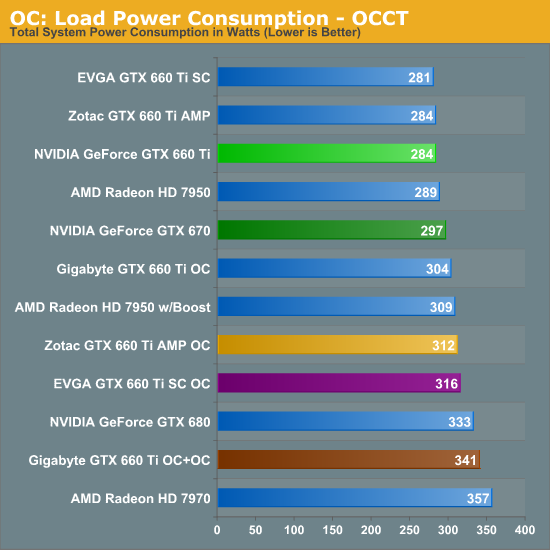
Unsurprisingly, given the small power target difference between the GTX 670 and the GTX 660 Ti, any kind of overclocking that involves raising the power target quickly pushes power consumption past the GTX 670’s power consumption. How much depends on the test and the card, with the higher power target Gigabyte card starting with a particular disadvantage here as its power consumption ends up rivaling that of the GTX 680.
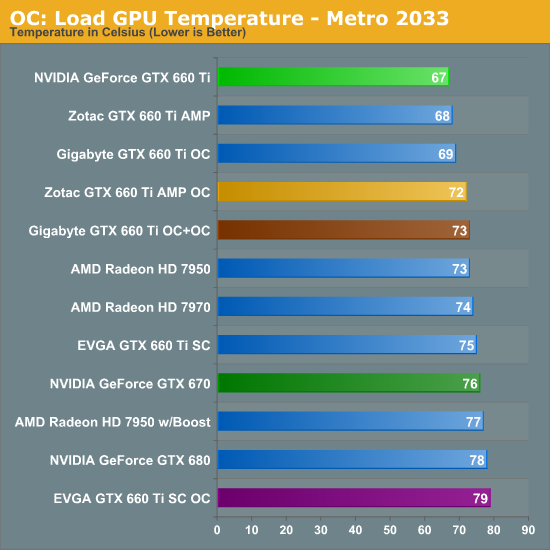
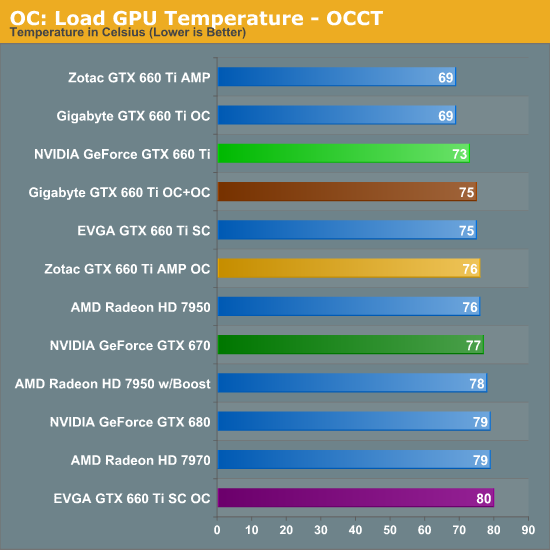
We also see the usual increase in load temperatures due to the increased power consumption. The Zotac and Gigabyte cards fare well enough due to their open air coolers, but the blower-type EVGA card is about as high as we want to go at 80C under OCCT.
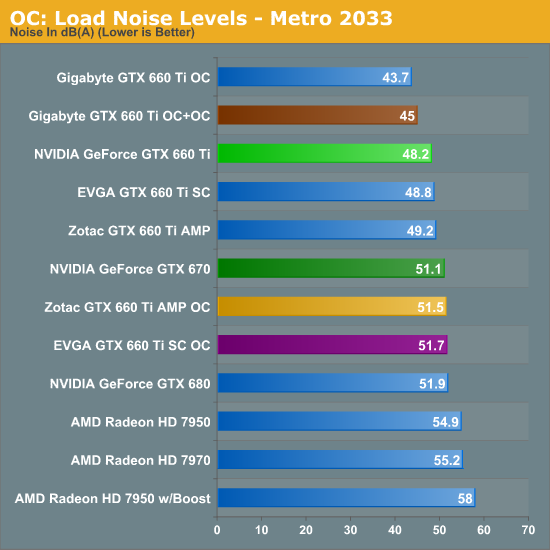
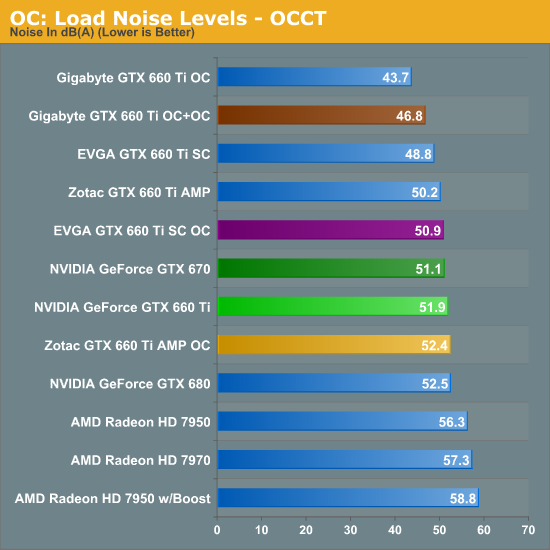
Last but not least, looking at noise levels we can see an increase similar to the temperature increases we just saw. For the Zotac and EVGA cards noise levels are roughly equal with the reference GTX 680, which will be important to remember for when we’re looking at performance. Meanwhile the Gigabyte card continues to shine in these tests thanks to its oversized cooler; even OCCT can only push it to 46.8dB.










313 Comments
View All Comments
PCTC2 - Thursday, August 16, 2012 - link
Pricing for GTX 660 Ti cards will start at $299, continuing NVIDA’s tidy hierarchyNVIDIA, not NVIDA.
PCTC2 - Thursday, August 16, 2012 - link
It's on page 2PCTC2 - Thursday, August 16, 2012 - link
I meant page 1. It's too early in the morning.haukionkannel - Thursday, August 16, 2012 - link
660ti is not bad, 7870 custom cooler version is very tough competitor. I allso would like to see factory overclocked version of AMD card in the same test, but all in all it seems to be close call.Nvidia definitely needs a cart to 200-300$. But it seems to be so that we have to wait untill 700 series for that?
RussianSensation - Thursday, August 16, 2012 - link
Not even. I don't think a 7870 is a competitor since it goes for $250-260 on Newegg. The real competitor is a $320-330 HD7950.MatthiasP - Thursday, August 16, 2012 - link
I don't get why Nvidia keeps ignoring the 200$ market. With economies in Europe and the US going down, i doubt that 300$ cards will be important for the mainstream market. And even there, the 7950 seems to be the better choice.Roland00Address - Thursday, August 16, 2012 - link
They are ignoring that market for they can't make money with it right now. Right now they are facing a shortage of 28nm wafers for TSMC can't produce enough chips right now. They usually make the most money with the $100 to $250 cards for they usually make money on selling high volume cards with low to medium profit.But due to the shortage of 28nm wafers they have decided to only target markets that are low volume and high selling price. Because of this there majority of 28nm wafers are going for the notebook chips they are producing (the 620m to 660m all have 28nm versions). They leftover spare chips they have are going to the gtx680, gtx670, and now gtx660ti which they make a lot of profit on.
Now there is a gt640 on the market right now, but it uses the same die as the 640m le to 660m, so any chips that can't make laptop grade due to not matching the 25w to 50w tdp will be reused in a desktop chip that can be up to 75w tdp where they will be sold at a final street cost of $100. $100 dollars for a 118mm^2 gpu is outrageous considering the 6670 has the same die size but is made on 40nm, outperforms it, uses less energy, and is cheaper.
You won't see a gt640 with gddr5, gt650, or a gtx660 (non ti) until nvidia gets more 28nm wafers. (You also won't see nvidia making 28nm tegras until they get more wafers even if the design for tegra4/wayne was finished right now.) Right now nvidia is a victim of its own success where it is selling every 28nm product it can make, so since it can't make any more 28nm products due to its suppliers and facing a shortage it might as well maximize its profits. $300 to $500 dollar cards maximize profits, Laptop Gpus maximize profits.
CeriseCogburn - Sunday, August 19, 2012 - link
" I don't get why Nvidia keeps ignoring the 200$ market. "560
560Ti
570
460 SLI
560 SE SLI
550Ti SLI
" I do get why amd fans pretend there are no nVidia cards "
TheJian - Monday, August 20, 2012 - link
Not ignoring it. They can't keep up with demand at $300. Your card is coming, but not until they can get more chips (more failed $300 ones?) so they can created a $200 card.Sorry already debunked your 7950 being the better choice. Ignore 2560x1600 and it's not even close. That being said, if you use a 30in monitor, maybe you can argue the 2560x1600, but it's a wash at that level as far as I can see. GTX 660 TI wins many times even in Anandtech's, etc..
thebeastie - Thursday, August 16, 2012 - link
I do almost all my gaming on my Sony HMZ-T1 in the standard 720P resolution, so would be great to see what FPS you get in slightly lower resolutions, especially since this is a card aimed at the lower end of the market.Would be great if you could start doing some 3D FPS benchmarks as well because there is a difference in performance again when you ad 3D rendering to any particular resolution.